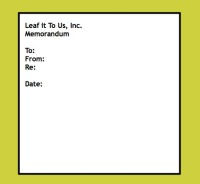Week Three: Rain garden memo (long post/read+re-read)
Stasis theory and the rain garden memo
The structure and type of paragraphs you will write follow Aristotle's stasis theory (very much a system of analysis and action, like your scientific method steps):
- Stasis 2: Definition overview PARAGRAPH 1 (what is a rain garden, briefly, by two functions)
- Stasis 2a: Classification PARAGRAPH 2 (what type of technology is this? Hint: low impact development and storm water management)
- Stasis 2b Elaborated definition in a Description PARAGRAPH 3
- (Illustrative; give detail on the layers of soil and the type of plants)
- Function by form -- which gives you Stasis 3 for practical causality)
- Stasis 4: Evaluation (is this good or bad? AKA do rain gardens work well? Use Dr. Davis' research (from Marybeth + the long PDF) as you do not have authority to evaluate based on your expertise)
Audience scenario for this memo: Here is Jane, our boss. She asked for the memo at the end of our last staff meeting.
 irst up! What is a memo?
irst up! What is a memo?
 By the way, the OWL website at Purdue is a fabulous resource for writing. Memos also have a standard format: See the image to the left. Also, look at the email heading in your software. This electronic message is based on the memo format. Bonus question: what is the difference, traditionally, between a memo and a letter.
By the way, the OWL website at Purdue is a fabulous resource for writing. Memos also have a standard format: See the image to the left. Also, look at the email heading in your software. This electronic message is based on the memo format. Bonus question: what is the difference, traditionally, between a memo and a letter.
Topic Sentences: A list of qualities for you to strive for
- Usually a short direct sentence (think announcement)
- Signals the topic in the paragraph (think preview)
- Hooks the reader by 1) raising a question or 2) provoking thought
- Can be placed anywhere, but early on in the paragraph is the best default strategy for most professional documents; in other words, at the beginning of the paragraph
- Contains an element of transition from the previous paragraph
Note: topic sentences can be implied in tightly coherent prose (for now, leave this subtle technique to the professionals!)
Let's look at examples of topic sentences useful in the rain garden memo:
Rain gardens, or bioretention ponds, are a kind of low impact development. Low impact development....
Rain gardens have two components: layers of percolation material and carefully chosen plants.
Rain gardens protect the local environment by absorbing water run-off from impervious surfaces and by sequestering pollutants.
Dr. Allen Davis studies rain garden effectiveness. Davis, a civil engineering professor, has been studying bioretention for more than twenty years.
Let's also think about sentences generally. General advice to you? Write shorter sentences than those you are familiar with in literature and many of your textbooks.
Now, let's think about sentences (links to shorr google docs): UPDATED FROM MONDAY! :)
And, on to paragraphs (short MS Word handouts):
Paragraph Types/Definitions: think Architectures
Paragraph Types by purpose (longer doc)
WEDNESDAY!
Picking up with stasis theory, a five-step hierarchy of categories to understand complexity. Here is a Google doc one-page that incorporates your rain garden memo (Assignment 1) work with many of of the stasis steps. Focus your thinking on the power of definitions. You are best helped in this document (pre-writing stage) if you have
- read Wikipedia entry about rain gardens and bioretention
- read several of my links about what stasis theory looks like (is precursor to scientific method)
For Friday, I will ask that you continue this prewriting work about rain garden content. Today, I want to show you a craft of writing that helps link prewriting/critical thinking work with the mechanics of writing this assignment.
Counting out! We will loop back to the paragraph types document posted Monday to look at the last paragraph about Jennifer Lopez. Then we will look at a Stephen King paragraph. For the rain garden work, I want you to think in patterns of two:

Hints (in the form of conjecture, which is stasis one):
What two environmental problems do rain gardens address?
storm water run off and pollution absorption
What two forms within rain gardens address these linked environmental problems?
inverted bowl shape+ layers of media type, carefully selected plants
What are two primary benefits of rain gardens, especially in urban environments?
environmental protection of the local watershed, low-cost, low impact last mile problem solution.
Next week, we will post (on Friday) a working draft of your memo for peer collaboration. Here is a Padlet link about how to approach peer editing. Note: you earn grades for this collaborative work.
On Friday, I introduce -- within a post nested here -- an incline plane to think about how to work with the shape of your memo. Think another triangle!
Take-aways?
- definitions are key to this informational memo
- counting out helps us select (invent) and arrange information for writing
- documents have a shape; the best shapes serve audience-context-purpose. You will open your memo with a small about of text in a short paragraph, then build to complexity with larger chunks of text.
Happy Friday!
If you like, you may preview Eli Review at this student-centered link. Do not triy to sign up, though. We will do that next week.
For today, I am available by the same GoogleMeet link in three chunks of time:
- 9-9:50
- 10:10 :0
- 11-11:50
Ok, that right triangle AKA an inclined plane: is a cognitive wedge approach to opening documents. Here are three gifs that help underscore what we will talk about next week:



Reader Comments